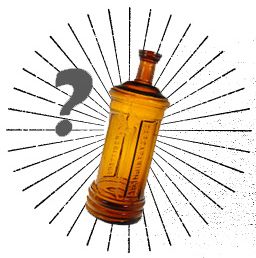When appraising bottles here at Historic Glasshouse, we always tell inform owners that their item’s value is dependent on condition. It is often not clear to the non-collector just what a “mint” or “perfect” bottle really means to the collector. You will often seen the terms “mint,” “perfect,” “sparkling mint,” “near mint” and a host of other modified terms suggesting the object in hand is unusually fine and has excaped the ravages of time and mishandling.
So what exactly is “perfect” or “mint” to the collector? Without question or qualification, we are talking about the condition when the bottle was removed from the mold and ready for use.
It should be enough to say that collectors are extremely fussy about condition. Glass is fragile so any piece that has survived not only intact but in perfect shape is unusual. It is also the general “grade” that most sought after, and even the most minor of chips, flakes, bruises, cracks, scratches, wear and the like have some effect on value.
Take a moment to re-examine the bottle that could casually be declared to be in “good” condition. Hold the object up to strong light and examine it from a variety of angles. Look for flakes of glass and cracks, especially at sharp corners, at the lip and at the base edge. Look for white stains or dullness on the inside or outside. Remember that when the bottle was made, it came out of the mold shiny all over. Look at the impurities in the glass to see whether their may be small cracks eminating from them. Do you see any scratches or scrapes? Is the glass worn or dull in any way? Are there chips or cracks or other pieces missing? Are there lines in the glass that shimmer as you turn the bottle in the light? It does not matter how minor these flaws appear to be – they are all flaws and to some degree, they have an impact on value and desirability.
Wear on the base of bottle is normal, lends authenticity and accepted by collectors. As long as it is limited to a dull ring around the base edge of bottle, it does not affect value. Some bottles will also have wear on the body or sides, especially on the high points. This type of wear shows use and will negatively affect value.
Bottles that have been unearthed from many years underground in dumps or privies are often described by collectors as in “dug” condition. Specifically, such items have milky white dull stains, rust stains, scratches, and wear. To the uninitiated, these bottles look genuine and old, but this appearance does not add to their value.
Stains and mineral deposits (a dull, white appearance on the glass) to some extent can be professionally polished or cleaned. Interior stain can often be polished without notice and should not affect value; however, a badly worn exterior might require excessive polishing which is usually a few strikes against
When describing the bottle to someone else, be sure to include as much detail as possible.
Imagine in your mind’s eye a scale from one to ten where the perfect bottle is a “10” and the one which is really rough and worn is a “1.” Chances are that the “really nice” bottle at hand is something like a “7” or “8” at best, and possibly even a lower grade than that. It takes time by virtue of comparing many examples and developing a critical eye to detect the differences.
